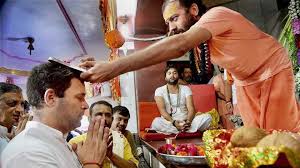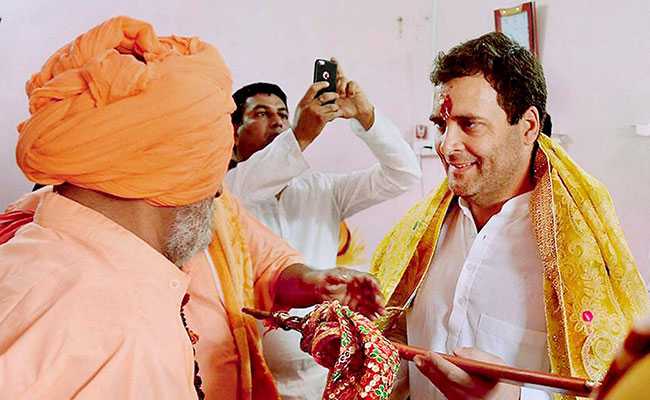Feature
Can Rahul’s Hinduism succeed where bogus secularism failed?

It will be impossible to resist the temptation of attributing Congress gains in the three northern states to Rahul Gandhi’s demonstrative adoption of Hinduism. In some measure, that is. There are two ways of looking at it. It is a trick which worked. Or is it the enunciation of a line which has to be developed?
So effective has been the Bharatiya Janata Party’s (BJP) saffronisation of the atmosphere that even Communists shy away from discussing minorities. West Bengal Chief Minister Mamata Banerjee has decided to build 10 Sun temples. Samajwadi Party’s Akhilesh Yadav will build a Vishnu temple. There is, of course, the biggest temple of all to be built in Ayodhya.

If Rahul places his new-found religiosity on a creative track, he can trump the BJP on that count too. Absurd though it may sound, he can, under certain circumstances, bring Muslims around to the idea that the ailing Lucknow cleric Maulana Kalbe Sadiq has been consistently propagating. Even if the Supreme Court verdict goes in their favour, Muslims should, in an act of magnanimity, help build the Ram temple. This cannot be expected of a community which sees itself as an object of hate. But if Rahul’s is an all-inclusive Hinduism where all are equal, well, the terms of endearment can change.
Rahul’s father, Rajiv Gandhi, after all, had the Ayodhya temple locks opened, an act which facilitated the temple movement. Rajiv promised “Ram Rajya” while inaugurating the 1989 election from Ayodhya. He allowed the bricklaying ceremony of the Ram temple on disputed land but asked officials to look the other way. He fell between stools. Gingerly flirting with Hinduism proved counter-productive. Rahul has come out overtly, causing some of us to smirk. How far will it go?
The Congress, as Rahul must know, was implacably opposed to the “Two Nation” theory — i.e., Hindus and Muslims constitute two distinct nations. Maulana Azad, President of the Congress from 1939 to 1945, had arrived at an agreement for an undivided India with the Cabinet Mission. He was unequivocal. “Partitioned India will be unadulterated Hindu Raj.”
It may have sounded rhetorical in the earlier years but where we have arrived is exactly what Azad had predicted. The Congress Working Committee meeting of June 3, 1947, accepted Mountbatten’s Partition plan. Why was Maulana Azad the only leader to have had serious misgiving? Frontier Gandhi, Khan Abdul Ghaffar Khan, wept. “You have thrown us to the wolves.” Only these two Doubting Thomases? All the others swallowed Partition hook, line and sinker? With some reluctance, even Mahatma Gandhi accepted Partition. At least this is what Azad writes in “India Wins Freedom”.
An endorsement of Mountbatten’s plan to divide India implied that the two-nation theory had been accepted. The creation of Pakistan was one step in that direction. Just as the neighbour was called Pakistan, could we not have been named Hindustan? In reality, we glided seamlessly from British Raj to Hindu Raj but, ridden by a guilty conscience, hesitated to spell it out. It is this hesitation which created room for the BJP to step in and grow.
If I were a Hindu, I would ask, as the late Vinod Mehta, my friend of 60 years, asked me in his Nizamuddin apartment: “800 years of Muslim rule, 200 years of the British and next door there is now a Muslim state. Against this backdrop, would you grudge me a Hindu state?”

Volumes would have to be written to focus on the nuances embedded in Vinod’s query but for purposes of a quick column this may be the appropriate moment to touch on issues now that the Indian National Congress has, with unprecedented honesty, embraced its Hindu credentials. And on current showing, the switch has been accepted by the people.
Nehru would have been uncomfortable with “Hindu Raj” for a variety of reasons, but the overriding reason for keeping aside “Hindu Raj” was realpolitik: What principle would then be cited to keep Kashmir?
When the founding fathers charted a course of neutrality, tolerance, respect for all religions without priviledging any one of them, they had probably not taken into account the crucial reality: A multi-religious, multi-ethnic, multi-lingual society frozen for centuries in a caste system, suddenly exposed to notions of democracy, upward mobility egalitarianism would create upheavals. A society inherently unequal was being set on a path of equality. The way ahead had to be unspeakably turbulent.
Add to this the following: The world’s largest minority and third-largest Muslim population which had no role in the creation of Pakistan found itself unable to produce that certificate of nationalism which is not available without a compulsive hatred for Pakistan. This hatred, tied with the televised image of Kashmiris as terrorists and Indian Muslims as a potential fifth column is a lethal mix, custom-made for a societal wreck, which is what we are today.
How can Rahul calm this cauldron? By deftly upping the ante for the BJP? While the Hindutva brigade is busy changing names of lanes and culverts, should he sail above the BJP? Should he insert in the Congress manifesto “Hindustan” as the official name to replace the ambivalence of “India that is Bharat”?
All of this flounders against the logic that Muslims and other minorities may not be comfortable with the overt Hinduisation of a party which has so far pretended to stand on a secular platform. There is an abundance of warped minds who are obstinately attached to labels like secularism without critically examining where this bogus secularism has landed them.
I constantly give the example of a society like Britain. Christianity is the official religion. This fact has not stood in the way of Sadiq Khan being the Mayor of London, Sajid Javed the Home Secretary and Moeen Ali as a regular man of the match and so on. This is not because the Anglo Saxon is inherently secular. This is so because the rule of law prevails, resulting in social harmony.
The Sachar Committee report on the socio-economic condition of Muslims was bad enough. In 70 years they have been brought down to the lowest rung. Hysterical focus by the electronic media on Pakistan, Kashmir and, by inference, Indian Muslims, has fouled up the atmosphere so much as to justify the Washington Post headline “Modi’s India is a living nightmare for Muslims”.
The results from the three northern states will serve as a balm. Let Rahul build upon it.
Entertainment
Meghalaya Reserves Legalized Gambling and Sports Betting for Tourists

The State Scores Extra High on Gaming-Friendly Industry Index
Meghalaya scored 92.85 out of 100 possible points in a Gaming Industry Index and proved to be India’s most gaming-friendly state following its recent profound legislation changes over the field allowing land-based and online gaming, including games of chance, under a licensing regime.
The index by the UK India Business Council (UKIBC) uses a scale of 0 to 100 to measure the level of legalisation on gambling and betting achieved by a state based on the scores over a set of seven different games – lottery, horse racing, betting on sports, poker, rummy, casino and fantasy sports
Starting from February last year, Meghalaya became the third state in India’s northeast to legalise gambling and betting after Sikkim and Nagaland. After consultations with the UKIBC, the state proceeded with the adoption of the Meghalaya Regulation of Gaming Act, 2021 and the nullification of the Meghalaya Prevention of Gambling Act, 1970. Subsequently in December, the Meghalaya Regulation of Gaming Rules, 2021 were notified and came into force.
All for the Tourists
The move to legalise and license various forms of offline and online betting and gambling in Meghalaya is aimed at boosting tourism and creating jobs, and altogether raising taxation revenues for the northeastern state. At the same time, the opportunities to bet and gamble legally will be reserved only for tourists and visitors.
“We came out with a Gaming Act and subsequently framed the Regulation of Gaming Rules, 2021. The government will accordingly issue licenses to operate games of skill and chance, both online and offline,” said James P. K. Sangma, Meghalaya State Law and Taxation Minister speaking in the capital city of Shillong. “But the legalized gambling and gaming will only be for tourists and not residents of Meghalaya,” he continued.
To be allowed to play, tourists and people visiting the state for work or business purposes will have to prove their non-resident status by presenting appropriate documents, in a process similar to a bank KYC (Know Your Customer) procedure.
Meghalaya Reaches Out to a Vast Market
With 140 millions of people in India estimated to bet regularly on sports, and a total of 370 million desi bettors around prominent sporting events, as per data from one of the latest reports by Esse N Videri, Meghalaya is set to reach out and take a piece of a vast market.
Estimates on the financial value of India’s sports betting market, combined across all types of offline channels and online sports and cricket predictions and betting platforms, speak about amounts between $130 and $150 billion (roughly between ₹9.7 and ₹11.5 lakh crore).
Andhra Pradesh, Telangana and Delhi are shown to deliver the highest number of bettors and Meghalaya can count on substantial tourists flow from their betting circles. The sports betting communities of Karnataka, Maharashtra, Uttar Pradesh and Haryana are also not to be underestimated.
Among the sports, cricket is most popular, registering 68 percent of the total bet count analyzed by Esse N Videri. Football takes second position with 11 percent of the bets, followed by betting on FIFA at 7 percent and on eCricket at 5 percent. The last position in the Top 5 of popular sports for betting in India is taken by tennis with 3 percent of the bet count.
Local Citizens will Still have Their Teer Betting
Meghalaya residents will still be permitted to participate in teer betting over arrow-shooting results. Teer is a traditional method of gambling, somewhat similar to a lottery draw, and held under the rules of the Meghalaya Regulation of the Game of Arrow Shooting and the Sale of Teer Tickets Act, 2018.
Teer includes bettors wagering on the number of arrows that reach the target which is placed about 50 meters away from a team of 20 archers positioned in a semicircle.
The archers shoot volleys of arrows at the target for ten minutes, and players place their bets choosing a number between 0 and 99 trying to guess the last two digits of the number of arrows that successfully pierce the target.
If, for example, the number of hits is 256, anyone who has bet on 56 wins an amount eight times bigger than their wager.











